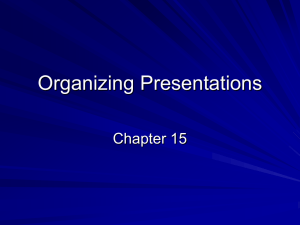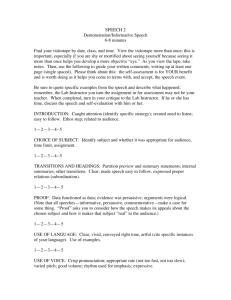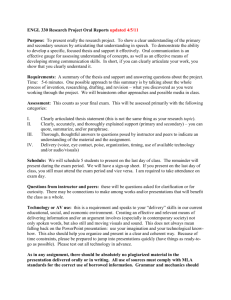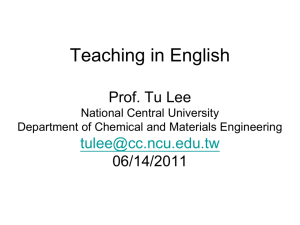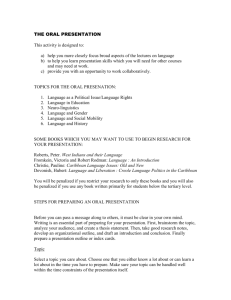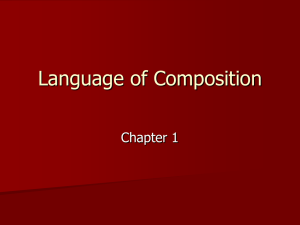Chapter 15 - Tomball FFA
advertisement
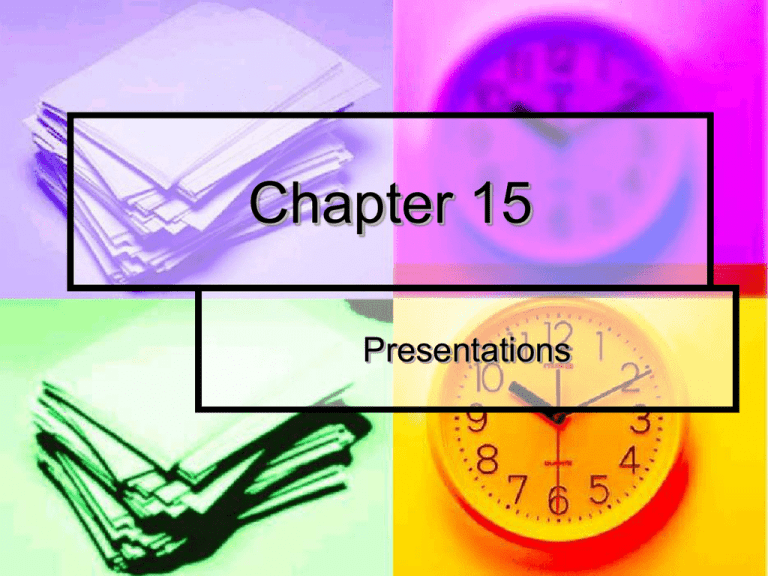
Chapter 15 Presentations Steps of the presentation process: 1. 2. 3. 4. 5. 6. 7. 8. Determine a topic Limit the topic Determine the purpose Research the topic Organize and outline Select supporting information Prepare notes and manuscripts for delivery Rehearse the presentation 3 elements of presentations: 1. 2. 3. Introduction Body Conclusion The Introduction: 5-10% of the presentation 1st impression The 5 purposes: 1. Get audience’s attention 2. State the thesis 3. Establish your ethos as a speaker 4. Orient the audience 5. Preview the main points Attention Device: Tool used by a speaker to grab the interest of an audience 7 popular attention devices: 1. 2. 3. 4. 5. 6. 7. Humor Quotations Stories References to the occasion,audience, or topic Rhetorical question Startling statement Personal experience PRACTICE: Develop three different attention devices for a topic Use any of the seven Thesis statement: Simple sentence of question that states the point you expect to make in your presentation Should guide your entire presentation Establishing Ethos: Provide information about yourself, your specific expertise, or research you have done Not all need to share their expertise Some people are introduced by someone else that gives this Audience Orientation: 1. 2. 3. Provides audience members with information they likely do not already have, but will need to understand the rest of the presentation 3 types: Definitions Background information Motivation (make them want to listen) The Body: Make up of 2-5 main points Each with supporting details and each connect with smooth transitions 75-85% of presentation Determining the main points: Consider the purpose of the speech 2. Refer to your thesis 3. Availability of information - have a topic you can back up - must have evidence 1. Transitions: Join main points Link introduction to conclusion Weak – leave audience feeling lost or wondering what the next point will be Smooth – shows relationship between two points being linked Transitions can help you: Put ideas together Illustrate a point Compare or contrast points Emphasize a point Arrange points in order Repeat or emphasize the main point Relate points through location or time The Conclusion: 3 purposes: 1. Summarize main points 2. Restate the thesis 3. Provide a clear ending Special strategies: Give different ending to the story Give a quote again Issue a challenge “What’s for lunch?” Patterns of Organization: Chronological Spatial Sequential Topical Cause-Effect Problem-solution Monroe’s motivated sequence Chronological Order: Arrange according to time of occurrence Main points pattern: past, present, future Can be used in formal or informal presentations Sequential order: Arrange according to the steps of a process Example: Steps in making a hamburger with the works Start from beginning to end PRACTICE: Show the steps in making a cake Don’t forget the all of the supplies you will need! Spatial Order: Arrangement according to how a topic is put together or by the physical location of its elements 1. Side to side 2. Top to bottom 3. North to south 4. East to west Example: a weather forcast PRACTICE: Describe your partner from head to toe Be specific Use descriptive adjectives Topical Order: Group by some logical theme or division Example: topic of deteriorating facilities at the school -look only at the gym, cafeteria, ag classrooms (only connection is deterioration Usually presented in order of importance Cause-Effect Used for persuasive and motivational presentations Cause (first part) brings about some action, event, or situation Effect (second part) consequences of 1st part Problem-solution Describe the problem and then a solution Usually used to persuade audience to solve a problem or improve a situation Advantage/Disadvantage Strategy: Effective if the speaker believes the audience is unlikely to accept the proposal Showing that he or she has considered the audience’s viewpoint helps overcome resistance Monroe’s Motivated Sequence: 1. 2. 5 part strategy for immediate action Persuasive or motivational speeches Based on two assumptions: All people have needs People can be persuaded by claims that satisfy those needs 5 steps: Attention: can’t persuade without it Need – make aware that the problem exists and is relevant to them Satisfaction – present solution Visualization – helps listeners “buy into your plan” Action
